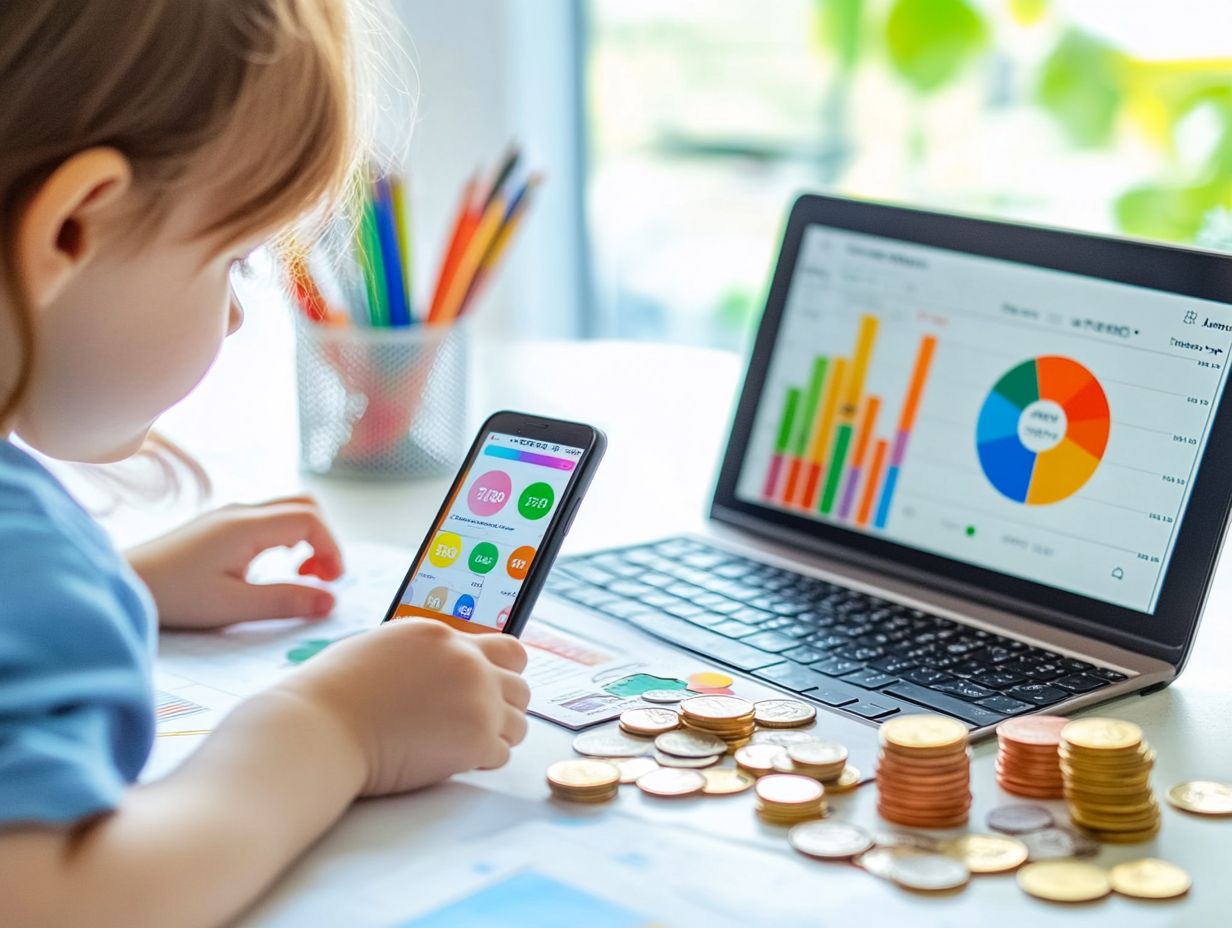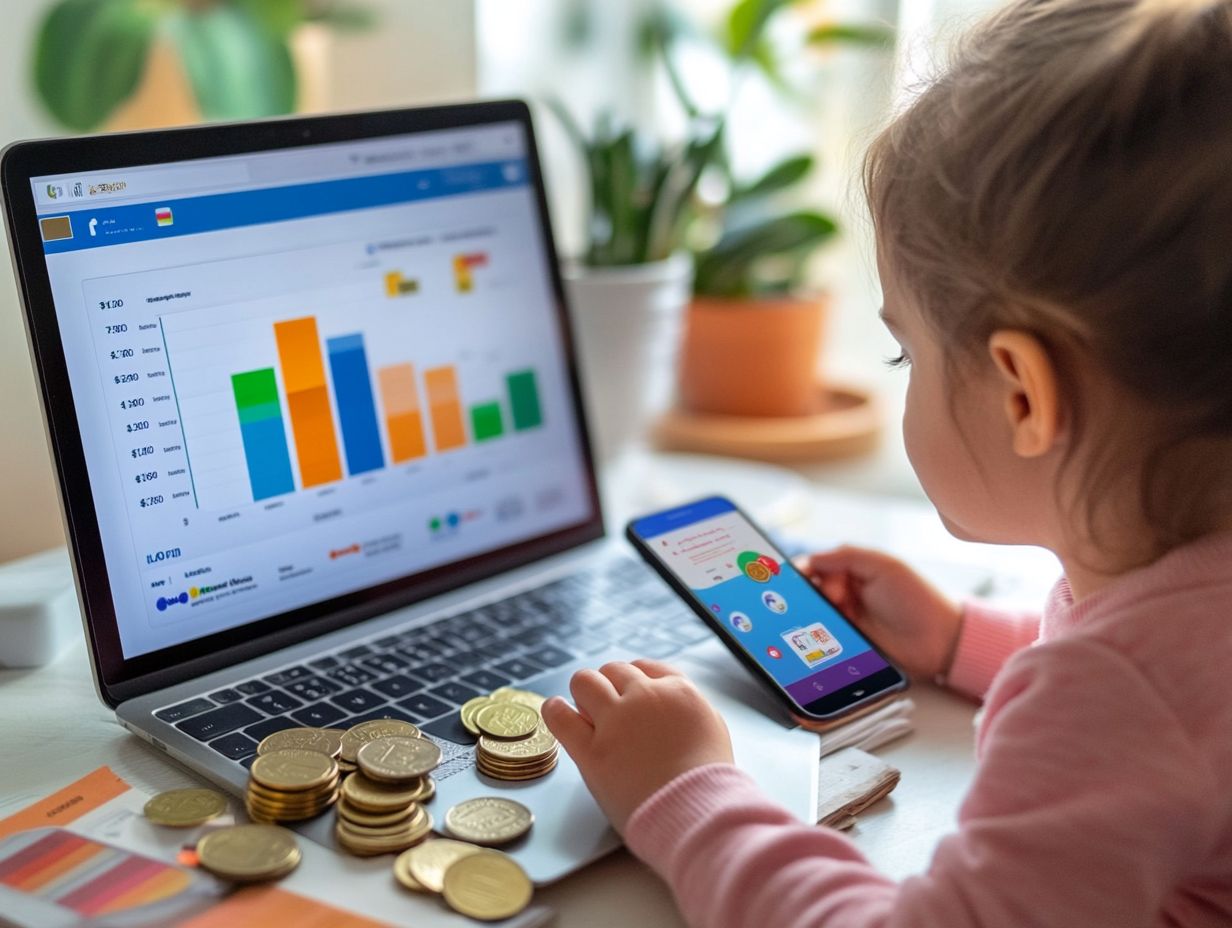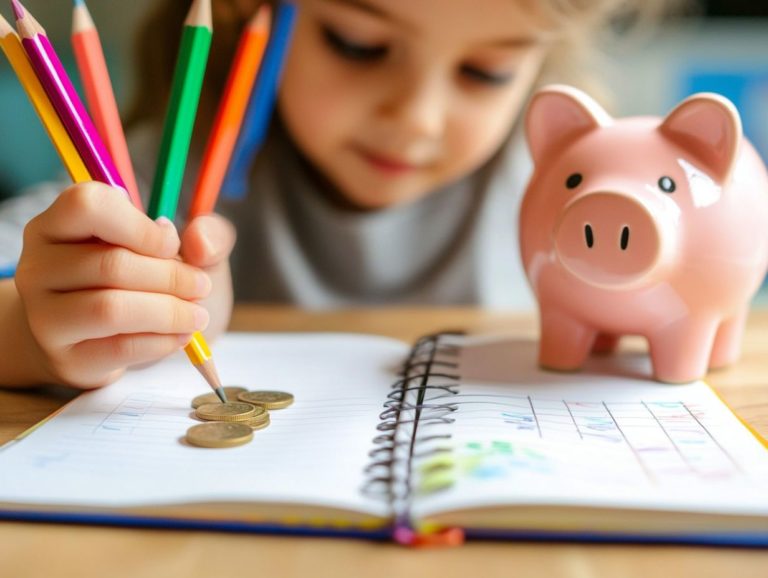How Can Kids Use Digital Tools to Track Their Spending?

Neale Godfrey is the financial voice for women and multi-generations and a world-renowned speaker and author, who has inspired millions through her work. She motivates, trains, educates, and frankly, entertains by delivering her core message: Empower yourself to take control of your financial life.
With technology constantly advancing, it’s very important to teach kids how to manage their money.
Learning how to handle money when young helps children grow responsible spending habits, learn the true value of money, and acquire vital budgeting skills.
This article explores various digital tools available for kids, including mobile apps and prepaid debit cards, and provides practical tips for using these tools effectively.
We will also give parents tips on supporting financial literacy in their children. Let’s help the next generation manage their finances!
Key Takeaways:
Why is it Important for Kids to Track Their Spending?

Teaching kids the importance of keeping track of their spending is important because it helps them become financially responsible for life and shows them how to handle money wisely.
By learning good spending habits early, children can tell the difference between what they need and what they want, set practical money goals, and manage their spending. This skill is especially important now, as managing online purchases and using budgeting apps affects how well they understand money. In fact, Edutopia highlights that teaching kids to manage money has significant long-term benefits. Related insight: Financial Literacy for Kids: Benefits and Activities.
1. Develop Responsible Spending Habits
Developing responsible spending habits is essential for kids as it equips them with the skills necessary to manage their finances effectively throughout life.
Providing kids with learning tools such as budgeting apps or fun workshops helps them learn the basics of saving, investing, and making good financial choices.
Practical experiences, like managing a small allowance or participating in family financial discussions, help to reinforce these concepts. When young people learn how their financial choices affect them, they develop responsibility that will benefit them as adults.
Managing money wisely leads to immediate benefits and helps establish good habits for making effective financial decisions over time.
2. Learn the Value of Money
Teaching kids about money is an important lesson. It helps them learn how money works and why saving is important.
When children understand money, they develop better saving habits and improve their financial knowledge as they grow up.
Practical activities like setting up a savings jar can help show them how to save for specific goals, making learning fun and informative.
Using apps designed for young savers, such as Greenlight or FamZoo, can make managing money engaging and educational. These platforms allow kids to track their savings, allocate funds for spending versus saving, and even learn about interest through gamified experiences. As highlighted by Success Magazine, their review of top money apps for kids underscores the effectiveness of combining technology with financial lessons.
This mix of education and technology builds a solid base, giving them skills they will use for their entire lives. To enhance this foundation, consider exploring how kids can set and achieve short-term savings goals, providing them with a structured approach to financial success.
3. Budgeting Skills
Learning how to budget is important for kids because it gives them control over their money and helps them reach their financial goals.
By incorporating various techniques and tools into their learning process, children can develop a strong foundation in money management.
Using budgeting apps can help young people keep an eye on their expenses easily, showing them how they spend money as it happens.
Hands-on activities, like creating a savings jar or organizing their weekly allowances, can reinforce these skills. Teaching kids to track their expenses is important.
It helps them see their spending habits and encourages them to spend wisely, guiding them to make better financial choices as they grow.
What are the Digital Tools Available for Kids to Track Their Spending?

There are many tools that help kids track their spending and manage their money, making it easier for them to learn about handling money. For instance, various kids finance apps offer features and parental controls that assist in monitoring their financial activities.
1. Mobile Apps
Mobile apps have become essential tools for kids to track their spending and develop budgeting skills in a user-friendly manner.
These applications make learning about finances easier and grab the attention of younger users with interactive functions.
Many people like Acorns, an app that rounds up daily spending and puts the leftover change into investments, highlighting the value of saving and investing gradually.
Goodbudget serves as an excellent digital envelope system, allowing kids to allocate funds for different categories and manage their budgets more effectively.
Greenlight stands out with its unique features, such as setting chores or allowances, while enabling parents to monitor spending in real-time.
By using these apps, children can learn financial responsibility in a fun way, helping them prepare for a more secure financial life.
2. Online Budgeting Tools
Online budgeting tools such as Mint and YNAB (You Need A Budget) offer interactive platforms that help kids learn to manage their finances. These applications provide user-friendly interfaces where young users can track their income, set savings goals, and categorize their expenses.
For instance, a child can input their allowance as income and allocate specific amounts for discretionary spending, such as snacks or games. By using these tools, they can visually see how each purchase affects their budget and make informed decisions.
Features like spending warnings and tracking financial goals involve kids in a fun way, helping them develop good money habits from a young age. This hands-on experience gives them important abilities that improve their grasp of managing personal finances. For those interested in a comprehensive overview of these apps, Investopedia’s comparison of YNAB vs. Mint provides detailed insights into their functionalities and benefits.
3. Prepaid Debit Cards
Prepaid debit cards are excellent financial tools that can teach kids about spending and managing money within a defined limit.
These cards provide a hands-on approach to financial literacy, allowing young users to learn the importance of budgeting and differentiating between wants and needs.
With each transaction, they can observe how their spending affects their balance, reinforcing essential financial lessons.
Parents can improve this learning experience by using built-in parental control features that let them watch spending habits and set limits on expenses. If interested, parents can also explore the GoHenry debit card for its educational benefits and practical features.
This oversight helps build responsibility and starts important conversations about money decisions and the importance of saving, helping children grow into informed and responsible adults.
How Can Kids Use These Tools to Track Their Spending?

Children can use different digital tools to manage their money. This involves creating budgets, keeping an eye on what they spend, and looking at how they handle their finances.
1. Set a Budget
Setting a budget is the first step for kids in managing their finances, as it helps them allocate their money towards different expenses and savings goals.
By creating a budgeting plan, young individuals can prioritize their spending, ensuring that they set aside enough for essential items while also working towards personal aspirations, such as a new video game or a special outing with friends.
This active method helps teach responsible money habits and highlights the importance of setting clear financial targets that influence their spending decisions.
Nowadays, different budgeting apps are important because they make it simple for people to keep an eye on their spending, see how they are doing with saving money, and change things as needed right away, helping them make better financial choices.
2. Track Expenses
Keeping track of spending is an important part of handling money well. It helps kids see how they spend their money and find ways to make better choices.
By using a step-by-step approach to tracking expenses, young people can build financial awareness and learn important budgeting skills that will be helpful as they grow up.
Apps for tracking expenses, spreadsheets, and online banking tools make it simpler to monitor how you spend your money.
For example, dedicated apps often sort purchases on their own, showing where most money goes. Spreadsheets can provide custom tracking options that help users examine their spending habits clearly.
Emphasizing such methods instills a strong sense of financial responsibility, encouraging a proactive mindset towards saving and spending wisely.
3. Categorize Spending
Categorizing spending helps kids understand their expenses better, allowing them to differentiate between needs and wants.
This awareness helps young people develop good financial habits as they see how their choices impact their savings and overall financial health.
By monitoring their expenses and setting specific categories for spending, they can manage their budget more effectively and make better decisions about what to buy later.
As children learn to create budgets for their allowances or gifts, they become more conscious of their financial wellbeing, developing skills that are essential as they grow.
This approach helps you handle money wisely and make good financial decisions as you mature.
4. Analyze Spending Patterns

Analyzing spending patterns is essential for kids to identify trends in their financial behavior and adjust their habits for better money management.
By regularly checking their spending, young people can find habits that might lead to extra costs, helping them change their spending wisely.
For instance, using budgeting apps like Mint or YNAB (You Need A Budget), children can categorize their expenditures and visualize where their money goes each month. This helps people know the difference between essential and non-essential extra spending while helping set goals using actual data.
As children gain knowledge about handling money, they will be prepared to save and make wiser decisions, leading to improved financial well-being.
What are Some Tips for Parents to Help Kids with Money Management?
Parents play a key role in helping their children learn to manage money effectively by giving guidance, resources, and tools that promote financial knowledge and responsibility. For an extensive analysis of this aspect, our comprehensive study on allowance management techniques explores various strategies and their benefits for children.
1. Lead by Example
Leading by example is one of the most effective ways parents can instill good money management habits in their children.
When they prioritize budgeting, save for long-term goals, and make informed spending decisions, children are more likely to internalize these behaviors.
For instance, involving youngsters in family discussions about financial planning can provide them with real-life scenarios to learn from. Parents who demonstrate the importance of setting aside a portion of their income for savings or who use shopping lists to avoid impulse purchases are creating a foundation for their children.
These actions teach kids the importance of money and how their spending decisions affect their finances later in life.
2. Involve Kids in Financial Decisions
Teaching kids about money choices helps them learn how spending and saving affect their finances, encouraging them to be responsible.
When kids discuss how to spend money, such as choosing a family vacation or deciding on school supplies, they begin to learn the value of money and why it’s important to make careful choices.
These conversations improve their ability to think critically about finances and give them the confidence to make independent decisions later on.
Working on budgeting together encourages open discussion, allowing children to express their thoughts and learn from their mistakes, which results in lifelong financial knowledge.
3. Teach the Importance of Saving
Teaching children the value of saving money helps them achieve their financial goals and understand planning for what lies ahead.
Parents can use different methods to make saving both educational and fun. One effective method involves the use of apps specifically designed for children that gamify the saving process, turning it into a fun challenge rather than a chore.
Visual savings trackers or jars marked for specific goals can motivate kids to take control of their savings. Talking with children about budgeting and saving can help them learn responsibility.
By allowing them to allocate a portion of their allowance or earnings into separate savings categories, youngsters will learn to appreciate financial goals and develop healthy saving habits from an early age.
4. Encourage Open Communication
Encouraging open communication about finances helps create a supportive environment where kids feel comfortable discussing money management.
This foundation is essential because it helps children learn the importance of money and lowers their worries about financial subjects.
Parents are key in helping with these talks by including lessons suitable for the child’s age on managing money, saving, and knowing the difference between desires and necessities.
Regular family gatherings to talk about financial aims or small choices can make money topics easier to understand.
Discussing common topics like planning a family trip can make conversations more engaging and relatable. This builds a feeling of responsibility and confidence for making financial choices later on.

Neale Godfrey is the financial voice for women and multi-generations and a world-renowned speaker and author, who has inspired millions through her work. She motivates, trains, educates, and frankly, entertains by delivering her core message: Empower yourself to take control of your financial life.






